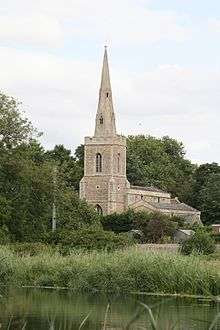St Peter's Church, Offord D'Arcy
St Peter's Church is a redundant Anglican church in the village of Offord D'Arcy, Cambridgeshire, England. It is recorded in the National Heritage List for England as a designated Grade I listed building,[1] and is under the care of the Churches Conservation Trust.[2] The church stands adjacent to the East Coast Main Railway Line, overlooking the River Great Ouse.[3]
| St Peter's Church, Offord D'Arcy | |
|---|---|
 St Peter's Church, Offord D'Arcy | |
 St Peter's Church, Offord D'Arcy Location in Cambridgeshire | |
| OS grid reference | TL 216 664 |
| Location | Offord D'Arcy, Cambridgeshire |
| Country | England |
| Denomination | Anglican |
| Website | Churches Conservation Trust |
| History | |
| Dedication | Saint Peter |
| Architecture | |
| Functional status | Redundant |
| Heritage designation | Grade I |
| Designated | 14 May 1959 |
| Architectural type | Church |
| Style | Norman, Gothic |
| Specifications | |
| Materials | Pebble and freestone Barnack limestone dressings |
History
The church dates from the Norman era in the 12th century, when the nave, chancel and north aisle were built.[1] The chancel was rebuilt at some time between 1250 and 1270. In 1320 the south aisle was added, followed by the west tower and spire in 1380. The spire was rebuilt in 1860, and repaired in 1990. The church continued to be the parish church of Offord D'Arcy until 1978, when its functions were taken over by All Saints' Church in the nearby village of Offord Cluny.[4] Towards the time it was declared redundant, people had to take umbrellas into the church and the heating no longer worked.[5] After it was taken over by the Redundant Churches Fund (the forerunner of the Churches Conservation Trust), the church was made weatherproof, and limited services were held in the summer months. Drama productions were mounted, and a candle-lit Christmas carol service was organised. In 2004 a three-day arts festival was held in the church.[5] During 2007 the Churches Conservation Trust carried out a programme of improvements to the church.[6] The church continues to be used for occasional services, open days, craft fairs, and other events, including a film festival.[7][8]
Architecture
Exterior
St Peter's church is constructed mainly of pebble and freestone, with dressings of Barnack limestone. Its plan consists of a nave with a clerestory and north and south aisles, a chancel and a west tower. The tower is in three stages standing on a splayed plinth. Its parapet is embattled with gargoyles at the corners. It is surmounted by a tall broach spire with two tiers of lucarnes. On the west side of the tower is a three-light window dating from the late 14th century. In the top stage are two-light bell openings on each side. The clerestory contains four two-light windows on both sides. In the south wall of the south aisle are three two-light windows and a doorway dating from the 13th century. In both the north and south walls of the chancel are a 15th-century window and a 13th-century lancet window. The east window dates from the late 15th century.[1]
Interior
The north arcade has three bays dating from the 13th century, with round-headed arches carried on square piers. The south arcade is in four bays with pointed arches. At the east end of the south aisle is a 13th-century piscina, and in the south wall of the chancel is another piscina from the same century. The monuments include 14th-century slabs in the north aisle carved with male and female figures. In the south aisle is a monument to Richard Nailour who died in 1616. It consists of an alabaster kneeling figure, flanked by Doric pilasters under an entablature with a segmental pediment. Also in the church is part of a 14th-century screen.[1] The two-manual organ in the west gallery was built in 1913 by Blackett and Howden of Newcastle upon Tyne, but it is no longer usable.[9] It is possible that the organ could be rebuilt at a cost in the order of £5,000.[10] There is a ring of three bells, but they are no longer ringable. The oldest was cast in 1618 by Tobias I Norris, the next in 1620 by William Haulsey, and the third in 1676 by Christopher Graye.[11]
See also
| Wikimedia Commons has media related to St Peter, Offord D'Arcy. |
References
- Historic England, "Church of St Peter, Offord Darcy (1130249)", National Heritage List for England, retrieved 10 April 2015
- St Peter's Church, Offord D'Arcy, Cambridgeshire, Churches Conservation Trust, retrieved 2 December 2016
- Offord Darcy, St Peter's Church, Britain Express, retrieved 9 January 2011
- A brief history of St Peter's Church, Friends of St Peter's Offord Darcy, retrieved 30 May 2011
- "Life after redundancy", Church Times (7409), 11 March 2005, retrieved 9 January 2011
- Refurbishment 2007, Friends of St Peter's Offord Darcy, retrieved 30 May 2011
- Welcome to the Friends of St Peter's Church Offord Darcy, Friends of St Peter's Offord Darcy, retrieved 30 May 2011
- Programme of events, Friends of St Peter's Offord Darcy, retrieved 30 May 2011
- "NPOR D00168", National Pipe Organ Register, British Institute of Organ Studies, retrieved 2 July 2020
- The Organ, Friends of St Peter's Offord Darcy, retrieved 30 May 2011
- Offord D'Arcy, S. Peter, Dove's Guide for Church Bell Ringers, retrieved 9 January 2011